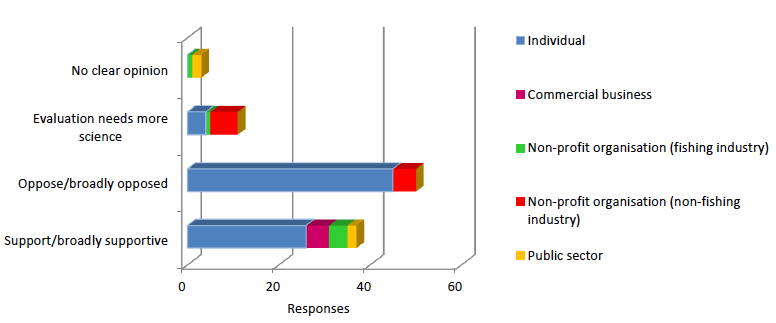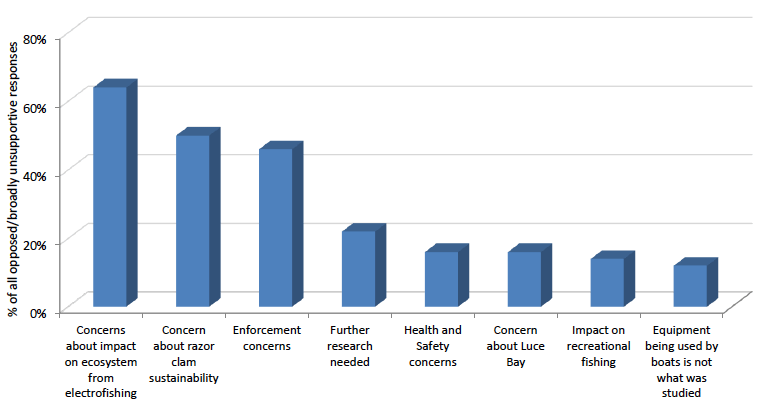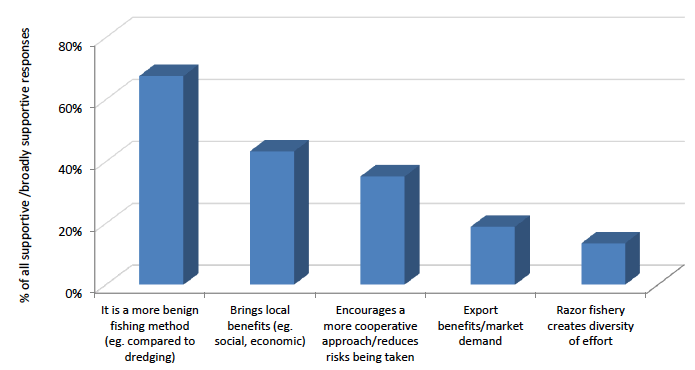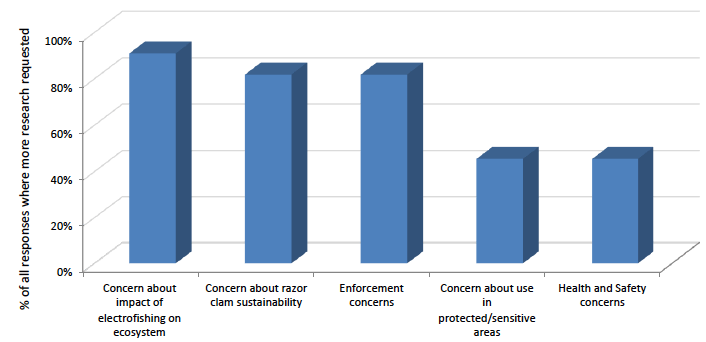Electrofishing for razor clams in Scotland: consultation analysis and Scottish Government response
The findings and outcome of the consultation on whether electrofishing should be a permitted method of harvesting razor clams.
Consultation analysis: electrofishing for razor clams in Scotland
Profile of respondents
1. A total of 104 responses were received; 74% from individuals and 26% from organisations. There were no campaign responses; however a few duplicate responses were received.
2. Counting duplicate replies once, respondents were divided into one of five categories based on information provided on their Respondent Information Form.
| Respondent category | Number | Percentage |
|---|---|---|
| Individual | 75 | 74% |
| Commercial business | 5 | 5% |
| Non-profit organisation (fishing industry) | 6 | 6% |
| Non-profit organisation (non-fishing industry) | 11 | 11% |
| Public sector | 4 | 4% |
| Total | 101 | 100% |
3. Two non-profit organisation (non-fishing industry) respondents endorsed the response from Scottish Environment LINK - as well as providing their own organisational response (which was worded differently, but tended to express the same points). River Ayr District Salmon Fishery Board endorsed the response from Ayrshire Rivers Trust but did not provide further comment.
4. Of the 104 responses received, 92 gave permission for their response to be published by the Scottish Government. These responses can be viewed at https://consult.scotland.gov.uk/marine-scotland/electrofishing-for-razor-clams/consultation/published_select_respondent
Analysis of responses
5. The consultation sought comments on a single question - whether electrofishing should in future be a permitted method for catching razor clams?
6. Responses were analysed by manually coding the themes identified by each respondent. This allowed trends among respondent groups to be highlighted. Four broad categories were identified:
- respondents opposed/broadly opposed to permitting electrofishing;
- respondents supportive/broadly supportive of permitting electrofishing;
- respondents who felt further scientific investigation is required before the electrofishing method can be properly evaluated; and,
- respondents who did not express a clear opinion.
7. The majority of individual respondents were not in favour of permitting electrofishing. Commercial businesses and non-profit organisations (fishing industry) tended to be supportive of electrofishing, whilst the majority of non-profit organisations (non-fishing industry) welcomed further research (see graph below).
Responses by group: Should electrofishing be a permitted method of catching razor clams?

Respondents opposed/broadly unsupportive of permitting electrofishing
8. With duplicate responses excluded, 50% of total responses were opposed/broadly unsupportive of catching razor clams by electrofishing. 90% of responses in this group were from individuals with the remaining 10% from non-profit organisations (non-fishing industry).
Key themes from responses opposed/broadly unsupportive of permitting electrofishing for razor clams

9. The majority (64%) of respondents in this group said they have concerns that electrofishing has a detrimental impact on the ecosystem, in particular on the benthic community or at different life stages of species. Anglers cited concerns about the effect of electrofishing on species such as tope and bass. Respondents felt that the 2014 study by Marine Scotland Science [1] was light on parameters considered.
10. Half of all respondents in this group expressed concern about the efficiency of the electrofishing method and the sustainability of local razor clam beds. Respondents said that they did not think current razor clam harvesting rates are sustainable. Many felt the efficiency of the method warranted its continued prohibition.
"There are too many that look at these as a way of making large and quick profit, with no thought about what the sustained impact is on the health of our ocean"
11. 46% of respondents in this group expressed concern about the current and/or future enforcement of the razor clam fishery. Many questioned how electrofishing would be monitored and controlled if it were legalised.
"If enforcing a ban on electrofishing of razor clams is difficult to enforce, will regulation of razor clam fishing be improved by legalising electrofishing?"
12. 16% of respondents in this group documented concerns with current illegal electrofishing practices in Luce Bay. A few other responses cited concerns in other areas including the Clyde, Orkney, Western Isles and Arran.
Respondents supportive/broadly supportive of permitting electrofishing
13. With duplicate responses removed, 37% of total responses received were supportive/broadly supportive of permitting electrofishing for razor clams. The group comprised individuals 70%, commercial business 14%, non-profit organisations (fishing industry) 11%, public sector 5%.
14. All commercial businesses (5) that responded to the consultation were in favour of permitting electrofishing for razor clams.
15. At least 58% of the individuals in this group referred to first-hand experience of electrofishing for razor clams.
16. 68% of respondents in this group stated that they thought electrofishing should be permitted because it is a more benign fishing method compared to other legal methods e.g. dredging. Respondents highlighted the selectivity of the electrofishing method and improved quality of the catch due to reduced physical damage during harvesting.
Key themes from responses supportive/broadly supportive of permitting electrofishing

"It would seem particularly perverse to apply legal and costly sanctions against people trying to earn a living by the most environmentally friendly means while, permitting and promoting more environmentally intrusive forms of fishing because the most damaging method is less effective at catching."
17. 43% of all respondents in this group highlighted the benefits they thought a razor clam fishery could bring, in particular economic and employment benefits to rural, fragile communities and the inshore fleet.
"With good domestic and export markets for razor clams the development of a small scale, well controlled, licensed fishery would be beneficial to fishing communities through the islands"
18. 35% of respondents in this group felt that if electrofishing were to be permitted it could encourage a more cooperative approach from the sector by bringing operators in from the dark. This in turn could reduce the 'cowboys' currently involved in the fishery and improve issues such as health and safety.
19. Although the consultation was not about how a razor clam electrofishery might be managed, many of these responses acknowledged that any such fishery would need to be well regulated to ensure it is sustainable, safe and well-managed.
20. A couple of responses referred to the minimum landing size for razor clams, implying that it should be >100mm. There was a suggestion that Inshore Fishery Groups might be best placed to develop and oversee Management Plans of the razor clam fishery.
Respondents who consider further research is required in order to evaluate electrofishing
21. With duplicate responses removed, 11% of total responses received concluded that more extensive scientific research was required before electrofishing could be properly evaluated, including 36% individuals, 9% non-profit organisation (fishing industry) and 55% non-profit organisation (non-fishing industry).
Key themes from responses that requested further scientific research

22. There is considerable overlap between the key themes from this group and the key themes that emerged from the group of responses opposed to permitting electrofishing (page 3). However, respondents in this group accept that there is credible evidence for considering a new approach to electrofishing because scientific research [1] suggests that electrofishing for razor clams causes fewer negative environmental impacts, when compared to other methods that are legal.
23. Whilst acknowledging the research findings, these responses encouraged a cautious approach and made recommendations on future scientific requirements i.e.:
- assessments of razor clam stock size and distribution;
- research on longer term effects of electrofishing on target and non-target species;
- evidence gathering on suitable minimum landing sizes;
- establish small-scale pilot studies where electrofishing as a commercial fishery is monitored; and,
- Appropriate Assessment as part of the Habitats Regulations Appraisal process.
Contact
Email: Access to Sea Fisheries
There is a problem
Thanks for your feedback